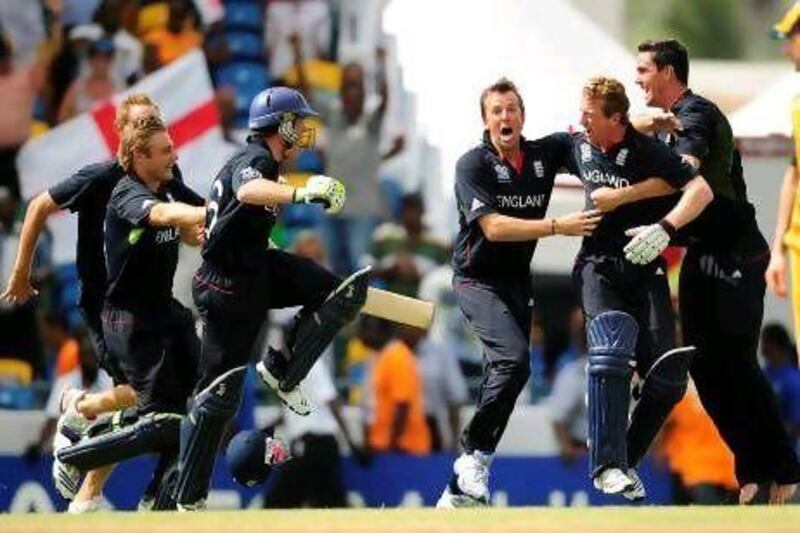Can what we see over the next two weeks really be Twenty20?
There will not have been any auction to buy the talent we will be watching. No franchise will have been tendered, or be going bust, or taking organisers to court (not yet anyway). No broadcaster, or sponsor, will suddenly pull out.
There should not be players complaining about not being paid (though as both Pakistan and Sri Lanka are involved that might be unavoidable). There will, hopefully, be no need for anti-corruption eyebrows to be raised. The tournament will not go on for months; it will be over in just 17 days.
It will not need a window in the calendar because it owns the calendar. And there will be no talk of blurring, shifting loyalties and tensions between club and country (given that a fifth of England's squad was born in South Africa, expect some snide remarks about loyalty to country and all that).
This will be the lot of the World Twenty20, T20 cricket without all the grist to the mill of the modern, kind of private Twenty20 leagues.
In fact, the World T20 is like the International Cricket Council's (ICC) own Twenty20 league, a world premier (mini-) league that spawned - and is still spawning - all other premier leagues.
It took the 50-over game 12 years to get to its fourth world cup; it's taken the 20-over version five years to do likewise and on the logic of ratios, that speed is almost perfect (20/50 nearly equalling 5/12).
Fifty-over cricket's fourth World Cup was a landmark, held in the subcontinent - and outside England - for the first time. At that precise moment cricket became new.
By contrast, you would be forgiven for feeling that the fourth World T20 already feels old and a little stale. That is not entirely its own fault but mostly because of format overkill.
It is debatable whether, for all its brevity, a Twenty20 is ever really over. Take just the big, spangly Twenty20 tournaments this year, the ones which attract players of all nationalities, are followed around the world and thus, if not in the forefront, persistently in the background.
All of January was occupied by Australia's Big Bash League. Then from February 10 began the first Bangladesh Premier League, concluding at the end of that month. The beginning of April to the end of May was reserved for the loudest of all, the Indian Premier League.
England's Friends Life T20 took up the format's burden from June 12 to the end of August, but with a total break of nearly six weeks in between. Not that if felt like relief because the Sri Lanka Premier League filled up three weeks in August.
In what gaps there are left regular T20 domestic tournaments occupied the mind. Next year, Pakistan and West Indies are trying to upgrade their T20 tournaments to shinier, richer versions. Soon there will be no respite.
So yes, if you are a bit blase about another Twenty20 tournament, that is understandable. Maybe this is what is called being old-fashioned, but there is still something about the best players in the world (except, of course, you know, Kevin Pietersen) assembling at one place to represent their countries in one tournament that rouses the mind.
One of the best things about it is that the format has still not found shape. The evolution is in progress. Trends and fashions, successful strategies are not easily identified, and neither does a particular style of play associate itself with a specific nation.
What is a competitive total? Are the end overs still best negotiated through yorkers? Is spin handier in the Powerplay or at the end? How much improvisation is too much?
Nobody really knows who or what a favourite is. Assessing form is perilous, not only because of the shortened nature, but also because there just are not enough international matches in a year.
In 2011 there were only 21 international Twenty20s. India have played only 12 international Twenty20s since the last World T20 in May 2010; the hosts Sri Lanka have played only 10.
Even if you consider Pakistan, who have played 22 matches since then - the most - that still means less than one T20 international a month.
Even the form of individuals is difficult to gauge.
Plenty of Chris Gayle, to use one example, has been seen even if he has not played for the West Indies so much. But most of the tournaments he has played in have put him against a varying mix of quality, of mostly domestic talent and a few international stars.
How ready is he, really, after 18 months away from international cricket? His teammate Sunil Narine is an IPL winner and bamboozler of the world at large, but this will constitute his first proper, sustained examination.
The two examples are deliberate. If the tournament has no obvious favourites, at least an unofficial consensus exists that places the West Indies back to the position they once held, as everybody's second favourite.
For everyone else we dangle in that space governed by "ifs": if David Warner and Shane Watson fire for Australia, if England overcome the absence of Pietersen, if Pakistan work out their balance, if Sri Lanka (and South Africa) stop fluffing the big games, if Yuvraj Singh shakes India out of its lethargy; here we dangle uneasily but excitedly.
Follow us
[ @SprtNationalUAE ]





